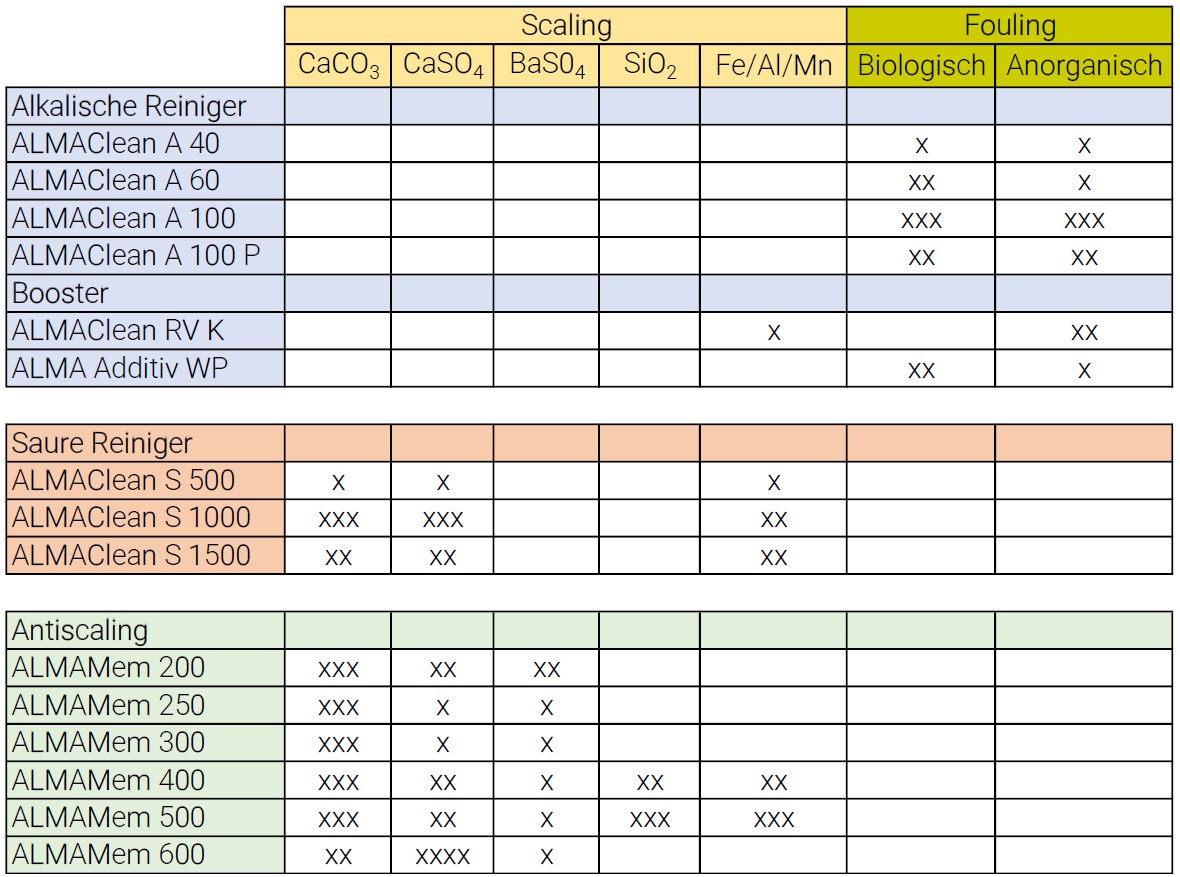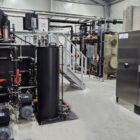Membranes are at the heart of many modern water and wastewater treatment systems, including reverse osmosis (RO), nanofiltration (NF), ultrafiltration (UF) and microfiltration (MF) systems. Despite their efficiency, membranes are susceptible to fouling and scaling, which can significantly affect performance. Regular use of membrane cleaners is essential to ensure the optimal function and service life of membranes.
The product range ALMA AQUA Mem product range from ALMAWATECH offers specialized solutions for the removal of various deposits and ensures efficient maintenance of membranes. This article deals with the technical background of membrane cleaners, typical challenges and practical solutions for system operation.
Table of contents
Functionality and types of membrane cleaners
Membrane cleaners work by chemical and physical mechanisms to dissolve and remove contaminants from the membrane surface. Different cleaners are used depending on the type of contamination:
1. acidic cleaners:
Application: Removal of inorganic deposits such as calcium carbonate, iron oxides or magnesium hydroxide.
Active ingredient base: phosphoric acid, citric acid or sulphamic acid.
How it works: The acidic active ingredients dissolve the deposits by protonation and solubilization.
2. alkaline cleaners:
Application: Removal of organic deposits, oils, greases and biofouling-causing substances.
Active ingredient base: sodium hydroxide, surfactants and enzymes.
How they work: The cleaners break down organic molecules and dissolve them through surfactant action.
3. special cleaners:
Application: Combinations of acidic and alkaline cleaners to remove complex deposits.
Examples: Removal of silicates, poorly soluble sulphates or biological films.
4. antifouling chemicals:
Application: Preventive measures to minimize fouling between cleaning cycles.

Photo: An excerpt from our ALMA AQUA Mem product portfolio. Acidic, alkaline and oxidative membrane cleaners and antiscalants.
Typical types of soiling and challenges
1. fouling:
Fouling is one of the most common types of fouling and is caused by the accumulation of organic substances, microorganisms and biofilms on the membrane surface. These deposits can drastically reduce the water flow through the membrane, which leads to increased energy consumption. At the same time, fouling favors the formation of biofouling, in which microorganisms continue to spread and their metabolic products can further damage the membrane. The consequences are reduced efficiency and a shortened service life of the membranes.
To combat this problem, targeted cleaning with alkaline membrane cleaners is required, which are able to effectively remove organic deposits and kill microorganisms.
2. scaling:
Scaling is caused by the precipitation of inorganic salts such as calcium carbonate, barium or strontium sulphate, which are deposited on the membrane surface. These deposits block the membrane pores and impair water transport, which reduces the permeate performance and increases the pressure on the system. In the long term, scaling can lead to irreversible damage to the membrane.
An effective solution is to use acidic membrane cleaners, which dissolve the inorganic compounds through chemical reactions and thus restore membrane performance.
3. colloidal deposits:
Colloidal deposits are caused by fine particles such as clay, silt or silicates contained in the feed water. These particles settle in the membrane pores and form a barrier that reduces water permeability. Colloidal deposits are particularly problematic as they are difficult to detect and often only become noticeable through a drastic drop in performance.
To remove such deposits, specialized membrane cleaners are used to detach the colloidal particles and at the same time prevent them from settling again.
4. chemical attacks:
Chemical attacks on the membranes can occur if unsuitable cleaning agents or incorrect dosages are used. This leads to damage to the membrane structure, which significantly impairs its separation performance and service life. Such damage is often irreversible and requires the membrane to be replaced, resulting in high costs.
To prevent this, it is important to use only specially formulated membrane cleaners that are compatible with the membrane materials used and ensure their chemical integrity.
Cleaning steps in practice
Chemical cleaning of membranes is carried out in a systematic process to maximize efficiency and prevent damage:
System preparation:
Switch off the system and drain the system.
Verification of the type of pollution through water analysis.
Prepare the cleaning solution:
Mix the cleaner in the recommended concentration (e.g. 1-2 %).
Control of pH value and temperature.
Circulation of the solution:
Circulation of the cleaning solution over a defined period of time.
Regular monitoring of pressure losses and turbidity.
Rinsing:
Remove the cleaning solution and rinse the membranes with clean water.
Recommissioning:
Checking the membrane performance and recording the results.
Advantages of the ALMA AQUA Mem product range
The ALMA AQUA membrane cleaners from ALMAWATECH have been specially developed for the efficient cleaning and maintenance of membrane systems. Their advantages include:
Highly effective: Special formulations for different types of soiling such as fouling, scaling and biofilms.
Gentle on materials: Developed not to attack the membrane materials.
User-friendly: Easy handling thanks to clear dosing instructions and extensive technical support.
Compatibility: Suitable for various membrane types and manufacturers.
Conclusion
Membrane cleaners are essential tools for the efficient operation and longevity of membrane systems. With the right selection and application, performance losses can be avoided and operating costs reduced. The ALMA AQUA Mem product range offers practical and highly effective solutions for a wide range of challenges.
For further information on our products, please feel free to contact us at any time!








